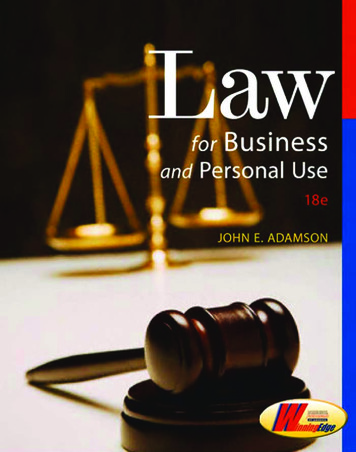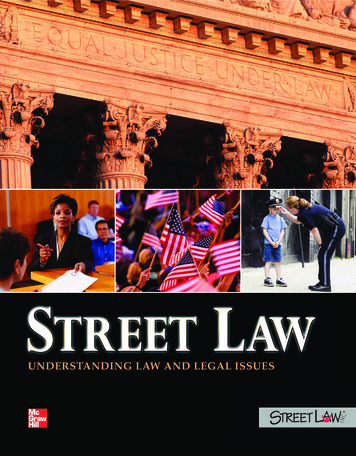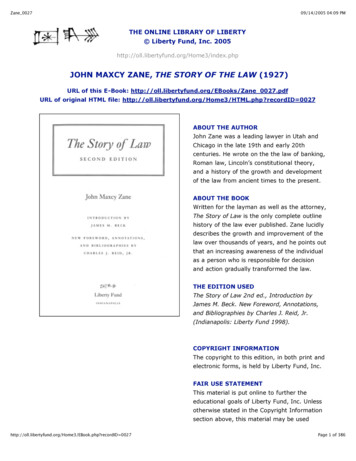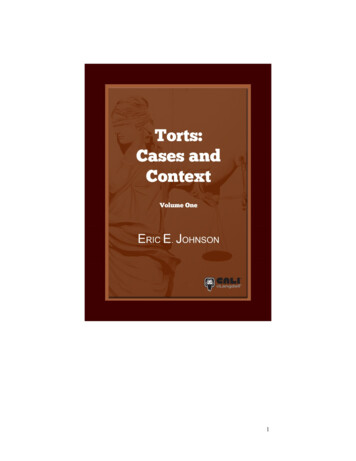
Transcription
Lawfor Businessand Personal Use18eJOHN E. ADAMSONAustralia Brazil Japan Korea Mexico Singapore Spain United Kingdom United States
Law for Business and Personal Use, 18th Edition 2009, 2006 South-Western, a part of Cengage LearningJohn E. AdamsonALL RIGHTS RESERVED. No part of this work covered by the copyright herein may be reproduced, transmitted, stored or used in anyform or by any means graphic, electronic, or mechanical, including butnot limited to photocopying, recording, scanning, digitizing, taping,Web distribution, information networks, or information storage andretrieval systems, except as permitted under Section 107 or 108 of the1976 United States Copyright Act, without the prior written permission of the publisher.Vice President of Editorial, Business: Jack W. CalhounVice President/Editor-in-Chief: Karen SchmoheExecutive Editor: Eve LewisSenior Developmental Editor: Enid NagelMarketing Manager: Valerie LauerFor product information and technology assistance, contact us atCengage Learning Academic Resource Center, 1-800-423-0563Marketing Coordinator: Kelley GilreathContent Project Manager: Jennifer A. ZieglerProduction Manager: Patricia Matthews BoiesSenior Technology Project Editor: Sally NiemanWebsite Project Manager: Edward StubenrauchManufacturing Coordinator: Kevin KluckEditorial Assistant: Virginia WilsonFor permission to use material from this text or product,submit all requests online at www.cengage.com/permissionsFurther permissions questions can be emailed topermissionrequest@cengage.comExamView and ExamView Pro are registered trademarksof FSCreations, Inc. Windows is a registered trademark of theMicrosoft Corporation used herein under license. Macintosh andPower Macintosh are registered trademarks of Apple Computer, Inc.used herein under license.The Career Clusters icons are being used with permission of the:Production Service: ICC Macmillan Inc.Senior Art Director: Tippy McIntoshInternal Designer: Trish Knapke, Ke DesignStates’ Career Clusters Initiative, 2007, www.careerclusters.orgCover Designer: Trish Knapke, Ke Design 2008 Cengage Learning. All Rights Reserved.Cover Image: Kelly Redinger/Design Pics/CorbisISBN-13: 978-0-538-44588-7ISBN-10: 0-538-44588-2South-Western Cengage Learning5191 Natorp BoulevardMason, OH 45040USACengage Learning products are represented in Canada byNelson Education, Ltd.For your course and learning solutions, visit school.cengage.comPrinted in the United States of America1 2 3 4 5 6 7 11 10 09 08
ReviewersBrenda Albright-BarnhartLinda HughesTammy SavageDigital AcademyCareer Tech DepartmentBolton High SchoolAlexandria, LouisianaBusiness EducatorRapides High SchoolLecompte, LouisianaBusiness Department ChairSpain Park High SchoolHoover, AlabamaKristine LabbusJanice B. SheltonJudith Kay BinnsBusiness Education InstructorNeenah High SchoolNeenah, WisconsinBusiness TeacherMills E. Godwin High SchoolRichmond, VirginiaJallane LinkLynn M. TaillonBusiness Education TeacherPuxico R-8 SchoolPuxico, MissouriBusiness Office TechnologyInstructorCanadian Valley Technology CenterChickasha, OklahomaBusiness EducatorCheshire High SchoolCheshire, ConnecticutLeo DunnCatherine McDonaldBusiness TeacherWaynesboro Area High SchoolWaynesboro, PennsylvaniaTeacher, Business DepartmentBryant High SchoolBryant, ArkansasDawna CarterInstructor, Business and TechnologyGreater Lowell Technical HighSchoolTyngsboro, MassachusettsSenior Teacher, BusinessRidgefield High SchoolRidgefield, ConnecticutNancy EversonBusiness TeacherBeloit Memorial High SchoolBeloit, WisconsinChair, Business EducationSun Prairie High SchoolSun Prairie, WisconsinChristine FerreiraBusiness TeacherAlgonquin Regional High SchoolNorthboro, MassachusettsRichard T. GordonLead Teacher, Business & AppliedTech DepartmentBloomington High SchoolBloomington, IllinoisVicki NossJeanne RobinsonTeacher, Business DepartmentSouth Technical High SchoolSunset Hills, MarylandThomasine MontoyaTeacher/CoordinatorCibola High SchoolAlbuquerque, New MexicoCaroline Janovec TassoneTamara M. TuckerTeacher, Business DepartmentColumbia High SchoolColumbia, South CarolinaGrant Pierce WilliamsBusiness Instructor/FBLA AdviserHarrison High SchoolHarrison, ArkansasKevin W. WillsonBusiness Education ChairYork Suburban Senior High SchoolYork, PennsylvaniaAbout the AuthorJohn E. Adamson is Emeritus Professor of Businessand Law in the Department of Finance and GeneralBusiness at Southwest Missouri State University.Adamson received a B.S. from the U.S. MilitaryAcademy at West Point, New York; an M.A. fromGeorgetown University; and an M.B.A. and J.D.from the University of Virginia at Charlottesville. Adecorated, disabled veteran and past mayor and schoolboard member of Miller, Missouri, Adamson is authorof numerous business law publications.Mock Trial ConsultantMelissa A. MarcinAttorney at LawMilford, OhioReviewersiii
ContentsUnit 1 Law, Justice, and You 2Planning a Career in Law: Trial Lawyer 3Entrepreneurs and the Law: Law, Justice, andYou 102Community Action: Get Out the Vote 103Winning Edge: FBLA Emerging BusinessIssues 103Mock Trial Prep: Concepts of Advocacy 104Features in Unit 1A Question of Ethics 17, 29, 57, 65, 87Cyberlaw 8, 86Economic Impact 66Global Issues 6, 32, 71Hot Debate 4, 24, 48, 64, 80In This Case 11, 16, 42, 54, 70, 73, 83, 85, 93Law Brief 9, 29, 58, 74, 94Legal Research 10, 38, 50, 69, 91Net Bookmark 19, 32, 53, 72, 95Online Research 97What’s Your Verdict? 5, 6, 10, 12, 13, 16, 25, 28,31, 33, 36, 39, 49, 52, 55, 57, 65, 67, 68, 71, 72,74, 81, 82, 83, 85, 89, 91, 93, 94, 96Chapter 1 Laws and TheirEthical FoundationChapter 4 Criminal Lawand Procedure1-11-21-3Laws and Legal SystemsTypes of LawsEthical Bases for LawsChapter 1 AssessmentSports & Entertainment LawChapter 2Constitutional Rights2-12-22-3Foundations of the U.S. ConstitutionDivision and Balance of GovernmentalPowersThe Internet and Constitutional RightsChapter 2 AssessmentSports & Entertainment LawChapter 3 Court Systems3-13-23-3ivForms of Dispute ResolutionThe Federal Court SystemState Court SystemsChapter 3 AssessmentCase For Legal 4-14-2Criminal LawCriminal ProcedureChapter 4 AssessmentSports & Entertainment LawChapter 5 Civil Lawand Procedure5-15-25-3646571767980Private Injuries vs. Public Offenses81Intentional Torts, Negligence, and StrictLiability85Civil Procedure93Chapter 5 Assessment98Sports & Entertainment Law101
Unit 2 Contract Law 106Planning a Career in Law: Franchisee 107Entrepreneurs and the Law: Contract Law 222Community Action: Positive Peer Pressure 223Winning Edge: FBLA MultimediaPresentation 223Mock Trial Prep: Case Scenario 224Features in Unit 2A Question of Ethics 112, 133, 148, 159, 183,193, 216Cyberlaw 134, 161Economic Impact 115, 171Global Issues 116, 132, 143, 157, 180, 207Hot Debate 108, 126, 140, 156, 170, 190, 206In This Case 109, 115, 119, 127, 130, 142, 147,159, 163, 173, 177, 181, 182, 193, 199, 208Law Brief 120, 132, 150, 158, 173, 193, 215Legal Research 110, 134, 150, 164, 178, 200, 210Net Bookmark 111, 133, 145, 158, 175, 198, 209Online Research 217What’s Your Verdict? 109, 110, 114, 116, 118,127, 128, 130, 131, 133, 141, 145, 147, 149, 157,160, 162, 163, 164, 171, 174, 177, 179, 181, 191,192, 197, 199, 207, 208, 210, 213, 214Chapter 6 Offer andAcceptanceChapter 10 Legal Purposeand Proper Form6-16-26-3Creation of OffersTermination of OffersAcceptancesChapter 6 AssessmentSports & Entertainment LawChapter 7 Genuineness ofAssent7-17-2109114118122125126Duress and Undue Influence127Mistake, Misrepresentation, and Fraud 130Chapter 7 Assessment136Case For Legal Thinking139Chapter 8 Consideration8-18-28-3108140Types of ConsiderationQuestionable ConsiderationWhen Consideration Is Not RequiredChapter 8 AssessmentSports & Entertainment Law141145149152155Chapter 9 Legal Capacity toContract1569-19-217010-1 Illegal Agreements10-2 The Statute of FraudsChapter 10 AssessmentSports & Entertainment Law171177186189Chapter 11 ContractualObligations and theirEnforcement19011-1 Transfer and Discharge of Obligations11-2 Remedies for Breach of ContractChapter 11 AssessmentSports & Entertainment LawChapter 12 ContractualAspects of Marriage andDivorce19119720220520612-1 Marriage and the Law of Contracts12-2 Divorce and the Law of ContractsChapter 12 AssessmentCase For Legal Thinking207213218221ContentsvContractual Capacity of Individualsand Organizations157Limits on the Rights of Those WithoutCapacity162Chapter 9 Assessment166Sports & Entertainment Law169
Unit 3 The Law of Sales 226Planning a Career in Law: Border PatrolAgent 227Entrepreneurs and the Law: The Law ofSales 278Community Action: Become a ConsumerActivist 279Winning Edge: FBLA Public Speaking I 279Mock Trial Prep: Case Law: Search andSeizure 280Features in Unit 3A Question of Ethics 230, 250, 270Cyberlaw 251, 264, 271Economic Impact 252, 268Global Issues 231, 244Hot Debate 228, 242, 258In This Case 232, 236, 244, 248, 270Chapter 13 Sales Contracts13-1 Sales13-2 Special Rules for Sales ContractsChapter 13 AssessmentCase For Legal ThinkingChapter 14 Ownership andRisk of Loss in Sales14-1 Transfer of Ownership14-2 Risk of Loss and Insurable Interestin SalesChapter 14 AssessmentCase For Legal ThinkingLaw Brief 232, 249, 261Legal Research 230, 251, 260Net Bookmark 233, 251, 261Online Research 273What’s Your Verdict? 229, 232, 234, 235, 243,245, 247, 249, 259, 260, 263, 266, 268228229234238241242Chapter 15 ConsumerProtection25815-1 Protection through GovernmentalAction15-2 Protection through Action by theConsumerChapter 15 AssessmentCase For Legal Thinking243247254257Unit 4 Property Law 282Planning a Career in Law: Title Examiner 283Entrepreneurs and the Law: Property Law 372Community Action: Protect YourEnvironment 373Winning Edge: BPA PresentationManagement 373Mock Trial Prep: Opening Statements374Features in Unit 4A Question of Ethics 291, 307, 326, 349, 365Cyberlaw 286, 320, 349Economic Impact 346Global Issues 290, 306, 325Hot Debate 284, 300, 314, 334, 356In This Case 286, 290, 301, 307, 319, 324, 338,344, 348, 359, 365viContentsLaw Brief 287, 306, 318, 345, 361Legal Research 293, 305, 317, 348, 366Net Bookmark 290, 303, 321, 343, 364Online Research 367What’s Your Verdict? 285, 289, 292, 301,302, 305, 307, 315, 319, 323, 325, 335,336, 338, 340, 343, 347, 348, 357, 360,364, 366259266274277
Chapter 16 Property and ItsAcquisition28416-1 Types of Property16-2 How Property Is Acquired and HeldChapter 16 AssessmentCase For Legal ThinkingChapter 17 Bailments17-1 Bailments17-2 Bailor and Bailee DutiesChapter 17 AssessmentCase For Legal ThinkingChapter 18 Ownership andLeasing of Real Property18-1 Ownership and Transfer of RealProperty18-2 Leasing Real PropertyChapter 18 AssessmentCase For Legal Thinking285289296299300301305310313Chapter 19 Insurance Law33419-1 Insurance Fundamentals19-2 Property and Casualty Insurance19-3 Life and Social InsuranceChapter 19 AssessmentCase For Legal Thinking335340347352355Chapter 20 Wills, Trusts, andEstates35620-1 Property Distribution Upon Death20-2 TrustsChapter 20 AssessmentCase For Legal Thinking357364368371314315323330333Unit 5 Agency and Employment Law 376Planning a Career in Law: PensionInvestigator 377Entrepreneurs and the Law: Agency andEmployment Law 458Community Action: Homeland Security atSchool 459Winning Edge: BPA Human ResourcesManagement 459Mock Trial Prep: Direct and CrossExamination 460Features in Unit 5A Question of Ethics 385, 404, 414, 436, 450Cyberlaw 429, 446Economic Impact 436Global Issues 388, 402, 420Hot Debate 378, 394, 410, 426, 442In This Case 381, 387, 398, 404, 414, 417, 428,433, 444, 449Law Brief 384, 403, 412, 428, 452Legal Research 380, 402, 416, 430, 447Net Bookmark 381, 396, 411, 434, 451Online Research 437What’s Your Verdict? 379, 380, 384, 386, 387,395, 396, 401, 404, 411, 413, 416, 417, 427,429, 432, 434, 435, 443, 447, 449Chapter 21 Agency Law378Chapter 22 Employment Law 39437938439039322-1 Making and Terminating EmploymentContracts39522-2 Duties of Employers and Employees 401Chapter 22 Assessment406Sports & Entertainment Law40921-1 Creation and Operation of Agencies21-2 Agency DutiesChapter 21 AssessmentCase For Legal ThinkingContentsvii
Chapter 23 Unions and theEmployment Relationship41023-1 Establishment of Unions23-2 Employment Relations in a UnionizedWorkplaceChapter 23 AssessmentSports & Entertainment Law411416422425Chapter 25 EmploymentRelated Injuries44225-1 Safety on the Job25-2 Employer’s Liability for Work-RelatedInjuriesChapter 25 AssessmentSports & Entertainment Law443447454457Chapter 24 Discrimination inEmployment42624-1 Legal versus Illegal Discrimination24-2 Proving Illegal DiscriminationChapter 24 AssessmentSports & Entertainment Law427432438441Unit 6 Legal Forms of BusinessOrganization 462Planning a Career in Law: CorporateAttorney 463Entrepreneurs and the Law: Legal Forms ofBusiness Organization 524Community Action: Ethical BusinessConduct 525Winning Edge: FBLA Business Plan 525Mock Trial Prep: Evidentiary Questions:Objections 526Features in Unit 6A Question of Ethics 467, 498, 512Cyberlaw 494, 516Economic Impact 488, 514Global Issues 473, 490Hot Debate 464, 486, 508In This Case 467, 472, 477, 487, 495, 502,509, 516Law Brief 480, 498, 518Legal Research 471, 501, 518Net Bookmark 466, 494, 517Online Research 503What’s Your Verdict? 465, 469, 473, 476, 479,487, 490, 493, 496, 500, 501, 509, 511, 514, 517Chapter 26 Forms of BusinessOrganization464Chapter 28 OrganizationalForms for Small Business26-1 Main Forms of Business Organization 46526-2 Creating and Terminating Partnerships 46926-3 Operating Partnerships476Chapter 26 Assessment482Case For Legal Thinking48528-1 Traditional Small Business Forms28-2 New and Evolving Small BusinessFormsChapter 28 AssessmentSports & Entertainment LawChapter 27 The Law ofCorporations27-1 Founding a Corporation27-2 Shareholders, Directors, and Officers27-3 Corporate Powers and TerminationChapter 27 AssessmentSports & Entertainment LawviiiContents486487493500504507508509514520523
Unit 7 Borrowing Money and Paying Bills 528Planning a Career in Law: ForensicAccountant 529Entrepreneurs and the Law: Borrowing Moneyand Paying Bills 614Community Action: Protect Against IdentityTheft 615Winning Edge: BPA ExtemporaneousSpeaking 615Mock Trial Prep: Closing Arguments 616Features in Unit 7A Question of Ethics 534, 554, 563, 578, 602Cyberlaw 539, 570Economic Impact 581, 604Global Issues 538, 548Hot Debate 530, 544, 560, 576, 592In This Case 533, 546, 553, 561, 569, 578, 584,594, 601Law Brief 531, 547, 568, 577, 605Legal Research 538, 551, 570, 584, 606Net Bookmark 534, 548, 564, 582, 599Online Research 609What’s Your Verdict? 531, 532, 537, 545, 546,551, 552, 561, 562, 564, 568, 577, 578, 581,586, 593, 597, 601, 604, 606Chapter 29 CommercialPaperChapter 32 Securedand Unsecured CreditTransactions53029-1 Basic Types of Commercial Paper29-2 Specialized Types of CommercialPaperChapter 29 AssessmentCase For Legal Thinking531537540543Chapter 30 Negotiability andNegotiation of CommercialPaper54430-1 Requirements of Negotiability30-2 Proper Indorsement and NegotiationChapter 30 AssessmentCase For Legal ThinkingChapter 31 Discharge ofCommercial Paper andElectronic Fund Transfers54555155655956031-1 Discharge of Commercial Paper31-2 The Law of Electronic Fund TransfersChapter 31 AssessmentCase For Legal Thinking56156857257557632-1 What Is a Secured Credit Transaction?32-2 How Are Security Interests Perfectedand Terminated?Chapter 32 AssessmentCase For Legal ThinkingChapter 33 Creditors,Debtors, and Bankruptcy57758158859159233-1 Legal Protection of Creditors33-2 Legal Protection of Debtors andCredit Card Users33-3 BankruptcyChapter 33 AssessmentCase For Legal Thinking593597604610613Appendix A Constitutionof the United States618Appendix B The Declarationof Independence630Glossary of Legal Terms633Case Index649Index652Contentsix
To the StudentYou will soon find business law is one ofyour most valuable subjects. You will studytrue situations that show how businessand personal law impacts not only business, butthe lives of young people and adults as well. Thelearning package will help you achieve an understanding of legal principles you will use throughout your life. Use the following plan to help youeffectively study Law for Business and Personal Use.How to Study the Textbook xEach chapter opens with a Hot Debate. Readthe Hot Debate scenario and then discuss withyour class the questions that go along with it.Each chapter is divided into two or three lessons. Each lesson has a list of Goals at thebeginning. Read the Goals and then scan thelesson to see where each goal is addressed.Read each lesson slowly and carefully. Makenotes of important points. In the StudentActivities and Study Guide, there is an outlineof every lesson to help you take notes.Each main topic heading is followed by a What’sYour Verdict? scenario. Try to answer the question. Then read the following paragraphs tolearn the law that applies to What’s Your Verdict?before you go on to the next topic.As you read, apply what you learn to yourown experiences or those of your family andfriends. Think about situations within yourown experience to which the law applies.At the end of each main topic section, askyourself the Checkpoint question to review thematerial.After you have carefully studied the lesson,complete the exercises in Think About LegalConcepts and Think Critically About Evidence.After you complete all the lessons in a chapter, read the Concepts in Brief to refresh yourmemory. Then complete Your Legal Vocabulary,Review Legal Concepts, Write About LegalConcepts, Make Academic Connections, andAnalyze Real Cases.To the Student The exercises in Think Critically AboutEvidence help you apply what you learned inthe chapter. Analyze Real Cases allows you towork with the facts from real lawsuits relatedto the topics in each chapter.Special Features A Question of Ethics presents ethical issuesthat arise within the legal framework.Cyberlaw discusses emerging legal aspects ofthe Internet and e-commerce.Economic Impact discusses a situation inwhich the law is affected by a certain economic circumstance.Global Issues illustrates legal procedures andissues in other nations.Hot Debate promotes thoughtful discussionof important legal issues.In This Case demonstrates legal principles andconcepts through hypothetical situations.Law Brief provides unusual or interesting factsor ideas related to the law.Legal Research helps you investigate issuesrelating to federal, state, and local laws usingInternet and library resources.Net Bookmark encourages you to use theInternet for research. Find the URLs you needto complete the research on the Xtra! web siteat school.cengage.com/blaw/lawxtra.Planning a Career in Law introduces you toseven law-related careers within various careerclusters.Online Research gives you a scenario andthen instructs you to use the Findlaw web siteto answer questions about it.What’s Your Verdict? motivates you to learnnew legal concepts.Mock Trial Competitions Mock Trial Prep features in each unit covercourt and trial procedures to prepare you forparticipation in mock trial competition.
Real-World Cases Case for Legal Thinking presents importantreal-world cases for analysis and discussion.Sports & Entertainment Law presents casesinvolving sports and entertainment figures.To analyze the dilemmas using fundamental ethicalrules, “Universalize” the action in question. Determine whether the action is irrational,illogical, or self-defeating.ProjectsHow to Read Case Citations Law cases are referenced in a way that makesthem easy to find. There are three parts to a citation. For example, 28 A2d 309 identifies (1) aseries of law books, (2) one volume in that series,and (3) the page where the case begins. In theexample, A2d identifies the series of books thatreport the decisions of certain courts. The Astands for Atlantic Reporter, a series that reportsthe cases of appellate courts in the North AtlanticRegion. The 2d indicates that the case appears inthe second series of the Atlantic Reporter. The 28in this example citation refers to Volume 28 inthe series. The case begins on page 309. Entrepreneurs and the Law allows you toapply the law to a start-up business situation.Community Action provides ideas for getting involved and making a difference in yourlocal, national, and global communities.Winning Edge helps you prepare for businesslaw-related FBLA and BPA competitive events.How to Analyze Legal SituationsFollowing each lesson and each chapter you willfind a number of legal situations in Think CriticallyAbout Evidence. You also will find actual cases thathave been decided by courts in Analyze Real Cases,Case for Legal Thinking, and Sports & EntertainmentLaw. You may use the same method to analyze allof these exercises. To answer the question raised,first read it carefully. Be sure you understand thequestion and the facts involved. Then determinethe rule of law involved and reach a decision. Youwill find it helpful to answer these questions. What are the facts?What is the disputed point?What rule of law is involved?How does this rule apply to the facts?What is the answer or decision?Legal AdviceConsult a lawyer if you have any doubts aboutyour rights or duties when your property, life,or liberty is endangered or if significant changesoccur in your circumstances. How to Analyze Ethical SituationsAn ethical dilemma is posed in A Questionof Ethics. You can use the ethical frameworksdescribed in Lesson 1-3 to analyze these dilemmas.To analyze the dilemmas using ethical reasoningbased on consequences, Describe alternative actions that wouldimprove the situation. Forecast consequences that would flow fromeach alternative described. Evaluate the consequences for each alternativeby selecting a standard for judging right orwrong consequences. Familiarize yourself with local, state, and federal laws to help avoid violations. Ignorance ofthe law normally is no excuse.Remember that as a minor you generallyare liable for crimes and torts and bound bycontracts.If you are involved in a legal dispute, try tolearn the other person’s version and honestlyseek a friendly solution out of court. In everycourt action at least one person loses and oftenboth find the costs burdensome.If someone injures you or your property, donot rush to sign a statement releasing the person from liability in exchange for some payment of money. The damages may be greaterthan they appear at first. Consult your attorney immediately.Although oral agreements can be legally binding, you should write out all contracts thatinvolve significant time, money, or detail andhave both parties sign and receive copies.To the Studentxi
Unit 1Law, Justice,and YouChapters1 Laws and Their EthicalFoundation2 Constitutional Rights3 The Court System4 Criminal Law and Procedure5 Civil Law and Procedure2
Planning a Career in LawTrial LawyerEMPLOYMENT OUTLOOK Employment opportunities for trial lawyersare expected to grow steadily through 2014,primarily as a result of growth in the populationand in the general level of business activities.Competition for job openings should continue to be keen because of the large numberof students graduating from law school eachyear. Graduates with superior academic recordsfrom highly regarded law schools will have thebest job opportunities.The willingness to relocate may be anadvantage in getting a job, but to be licensedin another state, a lawyer may have to take anadditional state bar examination.NEEDED SKILLS AND EDUCATION Prospective lawyers should develop proficiencyin writing and speaking, reading, researching,analyzing, and thinking logically. A multidisciplinary background is recommended.Students interested in a particular aspect oflaw may find related courses helpful.Courses in English, foreign languages, publicspeaking, government, philosophy, history,economics, mathematics, and computerscience, among others, are useful.The required college and law school educationusually takes seven years of full-time studyafter high school—four years of undergraduatestudy, followed by three years of law school.Law school applicants must have a bachelor’sdegree to qualify for admission.How you’ll spend your dayAs a new trial lawyer you’ll put in long hours assisting senior lawyers. The work involves fact gathering and legal research. The amount of informationyou’ll need to organize and sort before trial can bedaunting, but the work is excellent training. Afterawhile you’ll sit in on trials, participate in conferences with judges, and prepare arguments.Eventually you will represent your own clientsin court. In a criminal case you may representthe prosecution or the accused. In a civil caseyou’ll take the side of your client in a private dispute. Your job will be to persuade a jury of thefacts in the case. You’ll present the facts in a waythat best supports your client’s position, usingevidence to prove your case.When not in court you’ll review files, contactwitnesses, take depositions, and talk to your client.Preparing for a trial can take weeks or months.Many cases settle before they ever reach trial. Inthese instances you’ll work for the best settlementfor your client.On court daysyou’ll meetwith judges,select jurors,and argueyour case.What aboutyou?Does the jobof trial attorney interestyou? Whyor why not?Which aspectsof the jobwould youmost enjoy?Which aspectswould youleast enjoy? RUBBERBALLAre you good at arguing and debate?Do you like to defend others? Are youpassionate about justice being served forthe good of society? If so, you might consider acareer as a trial lawyer.Trial lawyers are needed in both criminal andcivil law courts. Trial lawyers must be able tothink quickly and speak with ease and authority.Knowledge of courtroom rules and strategyis particularly important in trial work. Triallawyers spend most of their time outside thecourtroom, conducting research, interviewingclients and witnesses, and handling other detailsin preparation for a trial. Criminal trial attorneyswork as defense attorneys or for the local, state,or federal government as a prosecutor.
Chapter 1Laws and TheirEthical FoundationWith her stereo system blasting, Clarisse began her drivehome from school in her small pickup. She was soonpulled over by a police officer. The officer cited her forviolation of the city’s noise ordinance. As he did so,his voice was partially drowned out by the sound ofjack hammers from a nearby construction site. Clarisseasked the officer why he had not cited the constructioncompany as well. He replied that, even though thecompany was in violation, the noise ordinance had beenput on the books to stop people from playing loud music in public, not to stop honest work.WHERE DOYOU STAND?1. Is the ordinance fair?2. Has the ordinance been fairly applied?3. Can you suggest some changes in the ordinance that might make it a better law?4Chapter 1 Laws and Their Ethical Foundation GETTY IMAGES/PHOTODISC1-1 Laws and LegalSystems1-2 Types of Laws1-3 Ethical Bases for Laws
1-1 Laws and Legal SystemsGOALSKEY TERMS Explain the stages in the growth of lawlawscodecommon law Describe the differences between common lawand positive law Identify the origin of the U.S. legal systemWhat Is Law?Two archeologists, ProfessorDiPalermo and ProfessorShuster, were deciphering somestone law tablets from the Middle East datingback before 2000 B.C.E. Looking up from hiswork, Professor DiPalermo commented that,while the amount of knowledge held byhumanity had increased dramatically, its basicnature had not changed. Professor Shusteragreed, saying, “Just compare the laws theyhad way back then with the ones we havenow. We’re still making the same mistakes andstill need the same protections from theconduct of others.”What'sYourVerdict?positive lawjurisdictionequityStages In the Growth of LawMost societies go through four distinct stages informing their legal systems:1. Individuals are free to take revenge forwrongs done to them2. A leader acquires enough power to be able toforce revenge-minded individuals to acceptan award of goods or money instead3. The leader gives this power to a system of courts4. The leader or central authority acts to preventand punish wrongs that provoke individuals toseek revengeThe laws, or enforceable rules of conduct in asociety, reflect the culture and circumstancesthat create them. Laws may be grouped into anorganized form referred to as a code. When youcompare one civilization’s code with the codes ofother civilizations, you see many similarities. Forexample, the law code set down about four thousand years ago by Hammurabi, King of Babylon,had sections on criminal law, property law, business law, family law, personal injury law, laborlaw, and others. Such coverage is similar to thatfound in the U.S. law codes today.The professors in What’s Your Verdict? werecorrect. The need for law has not changed muchover recorded history. People still make the samemistakes and still need the same protections fromthe conduct of others. NORTH WIND PICTURE ARCHIVESDo you think their observations arecorrect?The law code set down by King Hammurabi ofBabylon contained sections or categories similar tothose found in modern U.S. law codes. How do youthink the specific content of Hammurabi’s codescompares to that of U.S. law codes today?1-1 Laws and Legal Systems5
In the first stage, injuries inflicted on onehuman being by another are matters for personalrevenge. Those who are wronged feel that justicecan be done only through personally punishingthe wrongdoers. Gang wars in the inner citiesoften result from this type of attitude. Whetherthey occur in a big city or in a developingsociety, such events usually disrupt the normalproductive routine of the people and result inharm to innocent bystanders.The situation often leads to one individualtaking
and Personal Use 18e JOHN E. ADAMSON Law . of numerous business law publications. Mock Trial Consultant Melissa A. Marcin Attorney at Law Milford, Ohio Reviewers iii Reviewers. iv Contents Chapter 1 Laws and Their Ethical Foundation 4 1-1 Laws and Legal Systems 5 1-2 Types of Laws 10










